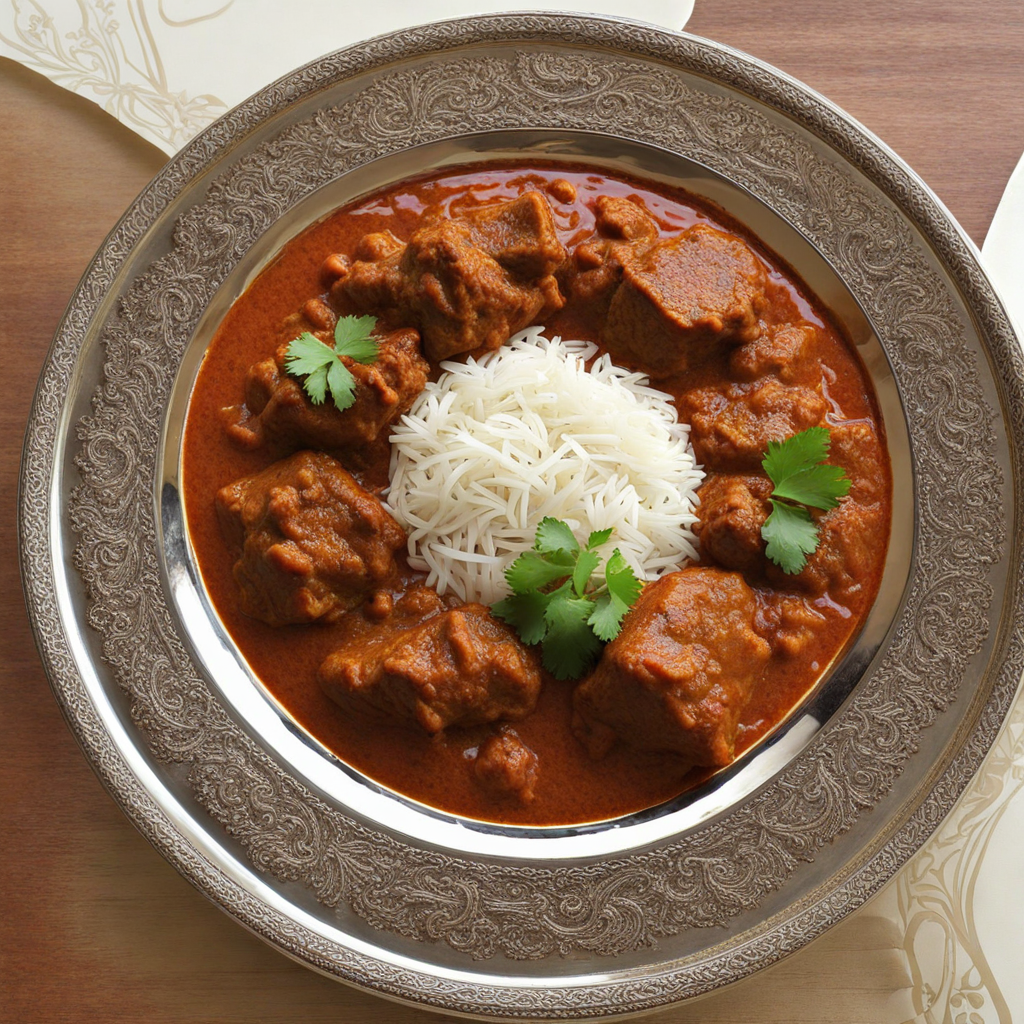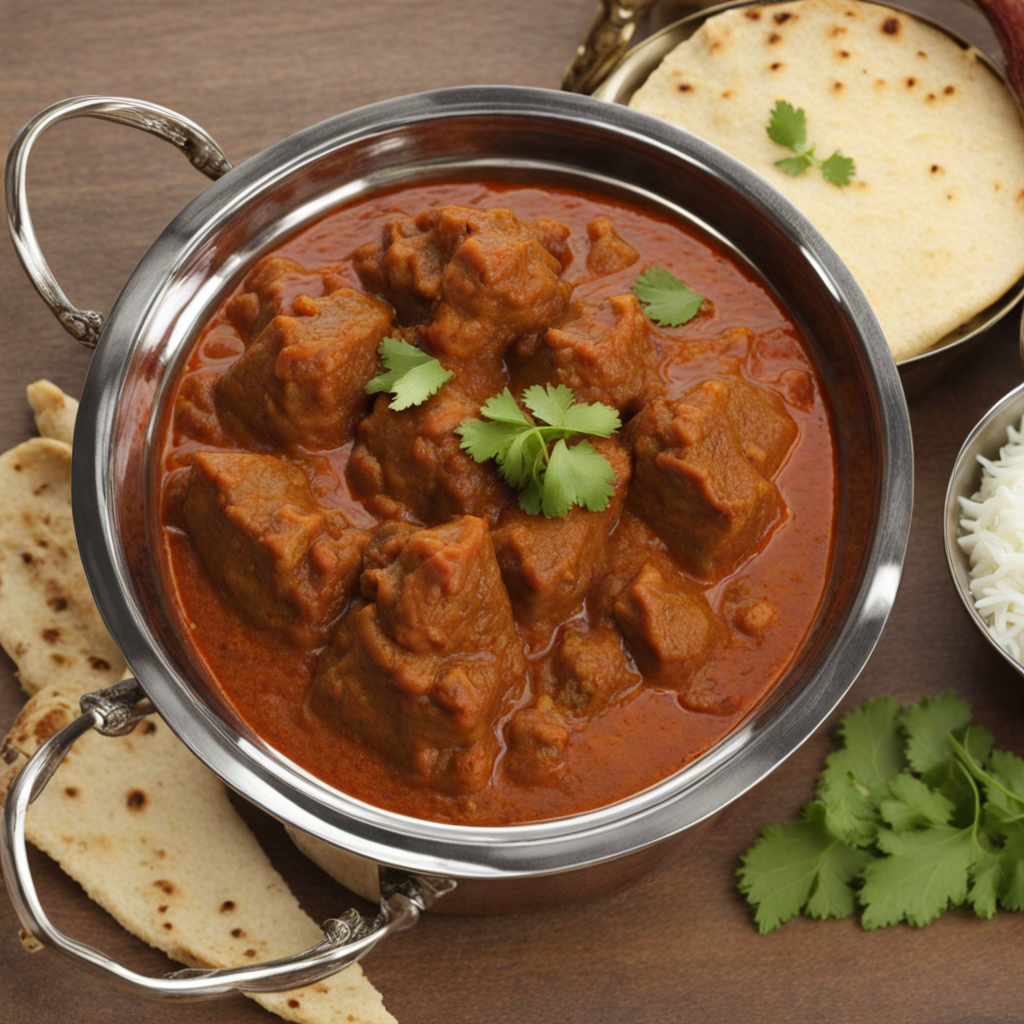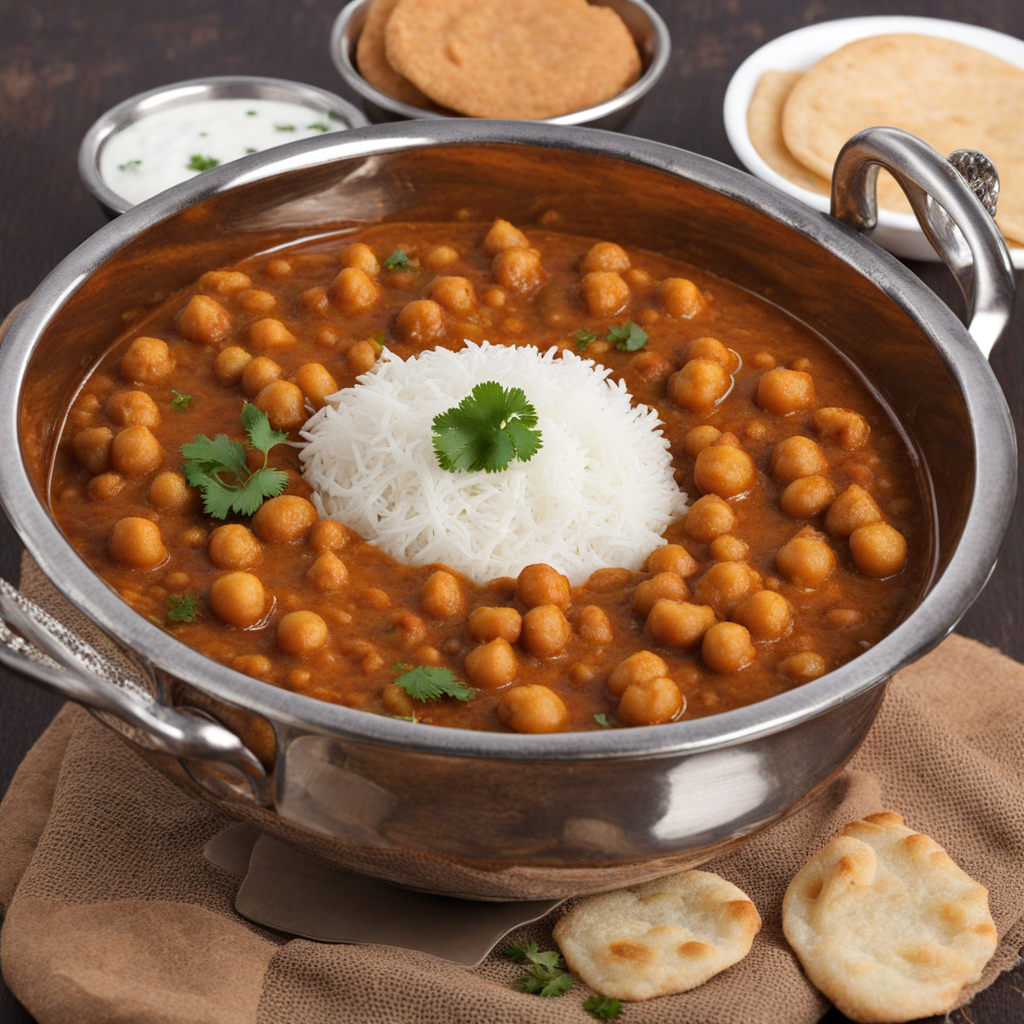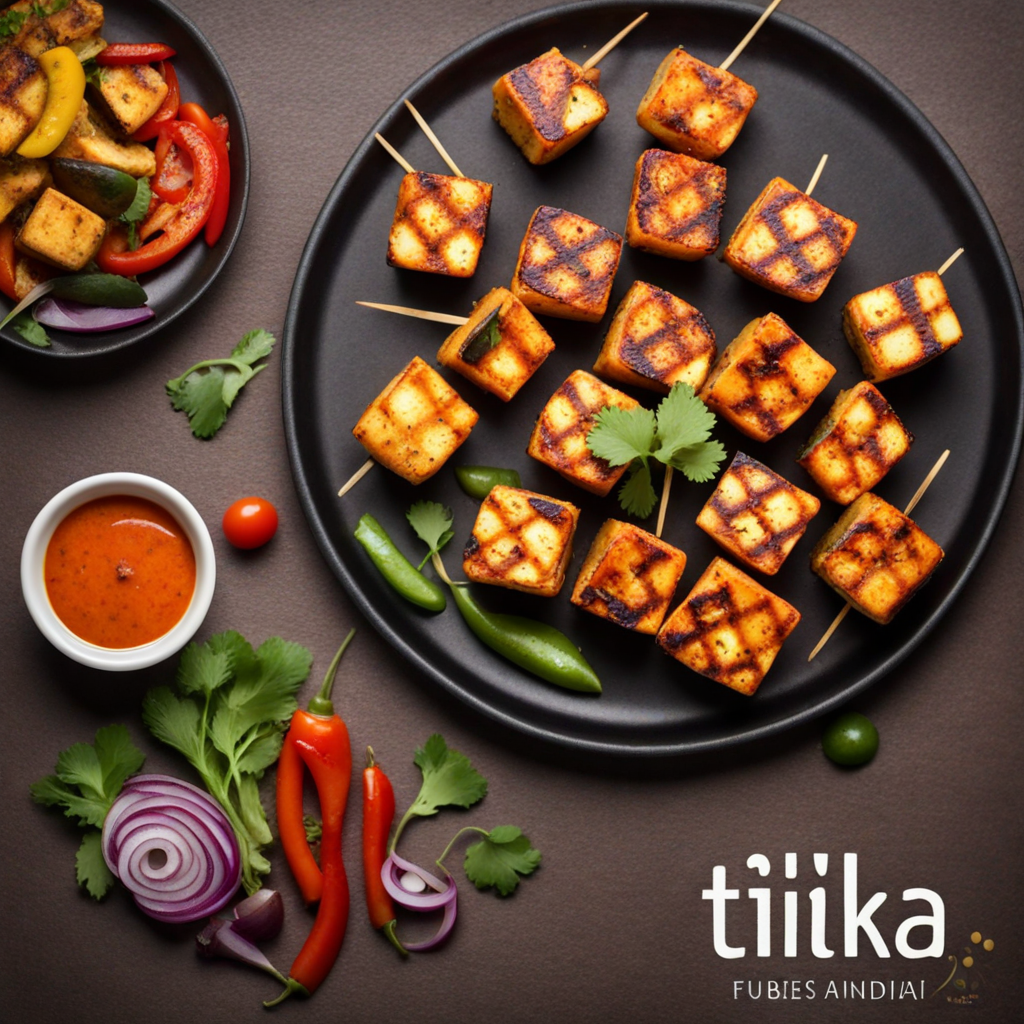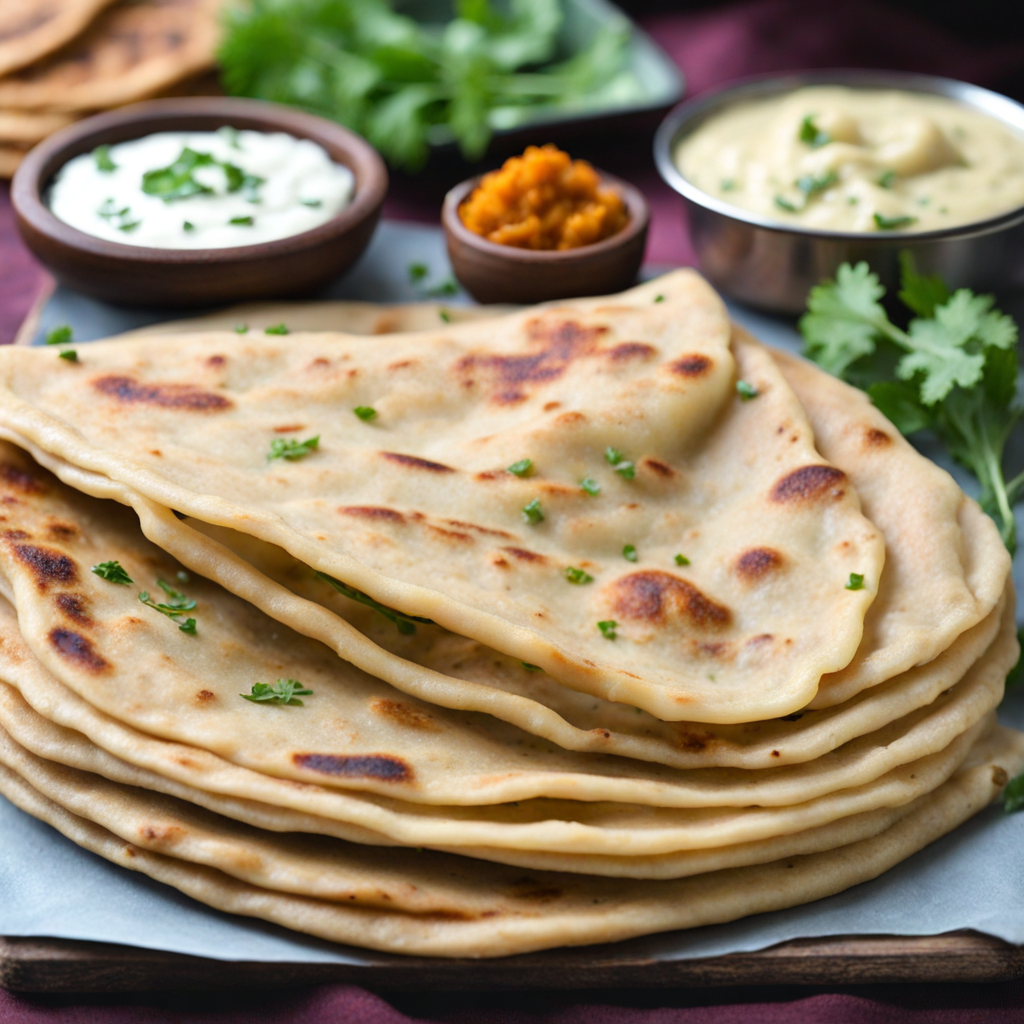Rogan Josh
Rogan Josh is a fragrant and richly spiced dish originating from the culinary traditions of Kashmir, India. At its core, it features tender pieces of lamb or goat that are slow-cooked in a blend of aromatic spices and a luscious gravy. The dish is known for its vibrant red color, which primarily comes from the use of Kashmiri red chili powder, giving it a mild heat and a stunning visual appeal. The slow-cooking process allows the meat to absorb the spices deeply, resulting in a dish that is both tender and flavorful, with a perfect balance of heat and richness. The spice blend used in Rogan Josh typically includes a variety of ingredients such as ginger, garlic, cloves, cardamom, and cinnamon, enhancing its complexity and depth. The addition of yogurt or cream adds a creamy texture that complements the spices, creating a luxurious sauce that clings to the meat. This dish is often served with steamed basmati rice or naan, which allows you to savor every last drop of the aromatic gravy, making each bite a comforting and satisfying experience. Rogan Josh is not just a meal; it is a celebration of flavors that reflects the rich cultural heritage of Indian cuisine. Its enticing aroma, vibrant color, and complex taste make it a must-try for anyone looking to explore new culinary experiences. Whether enjoyed at a traditional Indian restaurant or prepared at home, Rogan Josh promises to transport your taste buds to the enchanting valleys of Kashmir, leaving you craving more of its exquisite flavors.
How It Became This Dish
Origin of Rogan Josh Rogan Josh, a renowned dish from India, particularly associated with Kashmiri cuisine, has a rich and intriguing history that reflects the confluence of various cultural influences. The name "Rogan Josh" is derived from Persian, where "Rogan" means "red" and "Josh" means "heat" or "passion." This nomenclature is a nod to the dish's vibrant red color, which is achieved through the use of Kashmiri red chili, an essential spice in the preparation. Historically, the dish is believed to have been introduced to the Indian subcontinent by the Mughals in the 16th century, who were known for their love of rich and aromatic foods. The Mughals brought with them a sophisticated culinary tradition that combined Persian and Central Asian influences. Rogan Josh is a prime example of this fusion, showcasing the use of meat, spices, and slow-cooking techniques that were hallmarks of Mughal cuisine. Initially, it was prepared as a lamb dish, often using cuts that were tender and flavorful. The lamb, or goat meat, is typically braised with a blend of spices, giving it a distinctive, aromatic profile that has captivated palates for centuries. Cultural Significance in Kashmir In the context of Kashmiri culture, Rogan Josh is more than just a dish; it is a symbol of hospitality and celebration. It features prominently in the traditional Kashmiri feast known as "Wazwan," a multi-course meal that showcases the region's culinary artistry. The Wazwan is often served at weddings, festivals, and other significant gatherings, where it serves as a testament to the culinary heritage of Kashmir. The dish carries deep cultural significance within the Kashmiri Muslim community, where it is often associated with special occasions and family gatherings. The preparation of Rogan Josh is considered an art, with skilled chefs known as "wazas" mastering the intricate techniques required to achieve the perfect balance of flavors and textures. The dish is not only a staple of Kashmiri cuisine but also a symbol of the region's identity, reflecting the influences of various historical and cultural tides. Development and Variations Over Time As Rogan Josh gained popularity beyond Kashmir, it underwent various adaptations and interpretations, particularly in different parts of India and the world. In cities like Delhi and Mumbai, the dish has been incorporated into the mainstream Indian culinary repertoire, often served in restaurants that specialize in North Indian or Mughlai cuisine. While the traditional preparation remains true to its roots, variations have emerged that cater to local tastes and preferences. For instance, some chefs have experimented with different meats, such as chicken or beef, diverging from the original lamb or goat preparation. Additionally, the spice blend may be adjusted to suit regional palates, with some variations incorporating ingredients such as yogurt or tomatoes to create a creamier sauce. Despite these adaptations, the essence of Rogan Josh remains intact. The dish is still celebrated for its bold flavors and aromatic spices, which include cardamom, cinnamon, and cloves. The use of Kashmiri red chili not only imparts a vibrant color but also provides a distinct flavor profile that sets it apart from other curry dishes. This unique characteristic has allowed Rogan Josh to maintain its identity, even as it evolves in different culinary landscapes. Global Recognition and Influence In recent years, Rogan Josh has gained international recognition, becoming a staple in Indian restaurants worldwide. Its popularity can be attributed to the growing interest in Indian cuisine and the increasing appreciation for complex flavors and regional dishes. The dish has often been featured in various food festivals and culinary events, showcasing its versatility and appeal to a global audience. The globalization of Rogan Josh has also sparked a dialogue about food authenticity and cultural representation. Chefs and food enthusiasts are increasingly exploring the historical roots of the dish, emphasizing its significance in Kashmiri culture while also celebrating its adaptability in modern culinary practices. This movement towards understanding the cultural context of dishes like Rogan Josh has contributed to a broader appreciation of regional cuisines and their stories. Rogan Josh in Contemporary Cuisine Today, Rogan Josh continues to be a favorite among food lovers, both in its traditional form and in its modern interpretations. Home cooks and professional chefs alike experiment with the dish, often incorporating seasonal ingredients or innovative cooking techniques. The rise of social media has also played a significant role in popularizing Rogan Josh, with food bloggers and influencers sharing recipes, cooking tips, and visually appealing presentations of the dish. In contemporary kitchens, you might find chefs using sous-vide methods for cooking the meat, ensuring tenderness while infusing it with the flavors of the spices. Others may choose to present the dish with contemporary garnishes or side dishes, creating a fusion of traditional and modern culinary practices. However, the core principles of Rogan Josh—its rich spices, tender meat, and deep-rooted cultural significance—remain unchanged, allowing it to resonate with an ever-expanding audience. Conclusion The journey of Rogan Josh from its Mughal origins to its status as a beloved dish in global cuisine is a testament to its enduring appeal. It not only reflects the rich tapestry of Indian culinary traditions but also serves as a link to the cultural heritage of Kashmir. As food continues to evolve and adapt, Rogan Josh stands as a symbol of tradition, innovation, and the shared love for good food that transcends borders. Whether enjoyed in a lavish feast or a simple family meal, Rogan Josh is sure to leave an indelible mark on the hearts and palates of those who experience its unique flavors.
You may like
Discover local flavors from India


